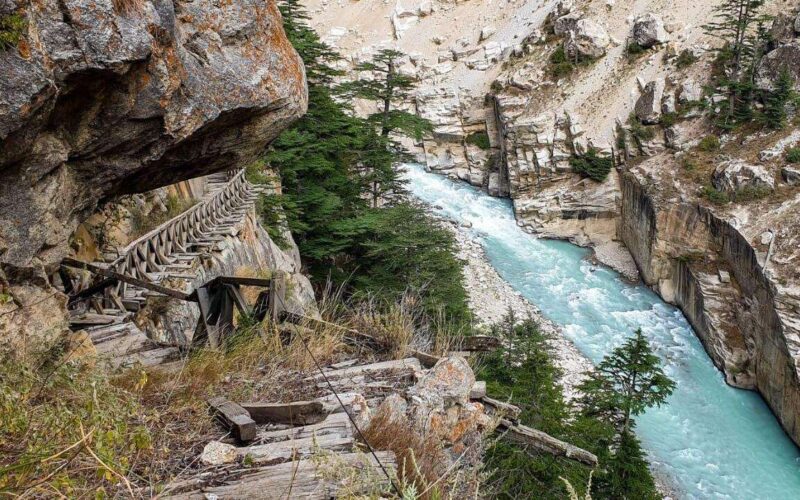<p><strong>Gartang Gali</strong>, Located near the Indo-China border at an altitude of 11 thousand feet above sea level. In the 17th century, the Pathans of Peshawar built the world&#8217;s most dangerous Skywalk by cutting the steep hills of the Himalayas in <a href="http://wildhawk.in/nelong-valley-unexplored-hidden-gem-of-uttarakhand/">the Nelang Valley</a> of Uttarkashi district at an altitude of 11 thousand feet above sea level. </p>



<p>This 150-meter-long wooden stepper street has been a witness to the Indo-Tibet trade. Situated in the Jad Ganga Valley of Uttarkashi district, this route is one of the most dangerous routes in the world.</p>



<p>Before 1962, Indo-Tibet merchants used to come by this route, carrying goods on yaks, horse-mules and sheep-goats. During the Indo-China war in 1962, <strong>Gartang Gali</strong> played an important role in taking the army to the international border. However, due to lack of maintenance the existence of Gartang Gali is in danger.</p>



<p>Sumla, Mandi, Neela Pani, Tripani, PDA and Jadugang are the last Indian posts on India-China border. In the 17th century, a Businessman of the Jad community, with the help of the Pathans of Peshawar, built a smooth route from Ghatang Gali on the demand of the traders.</p>



<figure class="wp-block-image size-large"><img src="http://wildhawk.in/wp-content/uploads/2021/05/gartang-gali-uttarkashi1.jpg" alt="gartang gali" class="wp-image-2894"/><figcaption>Gartang Gali</figcaption></figure>



<p>Being strategically sensitive, this area has been declared as Inner Line Area. In 2015, with the efforts of the District Hotel Association and other institutions, the government opened it for tourists. However, the situation remains the same. No one knows when the historical steps of this gali will break and fell down. </p>



<p>Before the India-China war of 1962, traders used to reach Badahat with wool, leather garments and salt by this route. After the war, movement on this route stopped, but the movement of the army continued. Nearly ten years later in 1975, the army has also stopped using this route.</p>



<figure class="wp-block-image size-large"><img src="http://wildhawk.in/wp-content/uploads/2021/05/n3-1024x640.jpeg" alt="nelong valley" class="wp-image-2895"/><figcaption>Nelong Valley</figcaption></figure>



<h3 class="wp-block-heading"><strong>Permission to go to Nelang Valley</strong></h3>



<p>In view of the situation created after the Indo-China war in 1962, the Government of India had banned the movement of tourists in the Inner Line area of ​​Uttarkashi. Since then, the Nelang Valley and Jadung village were evacuated and paramilitary forces were stationed there.</p>



<p>Native villagers are allowed to worship their deities once a year after completing certain formalities. In 2015, The Home Ministry of India gave permission to the common people of India to reach Nelang Valley, although the ban on foreigners remains intact.</p>

